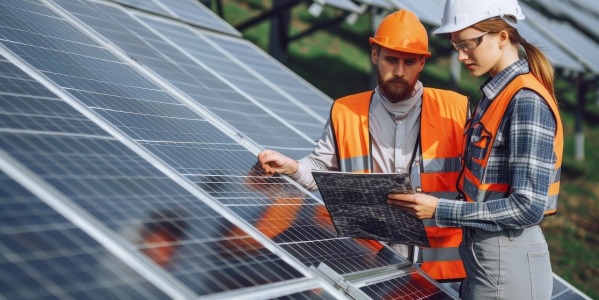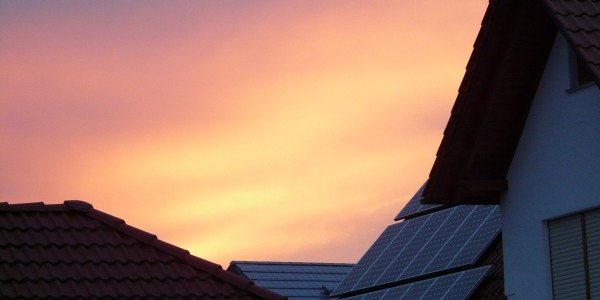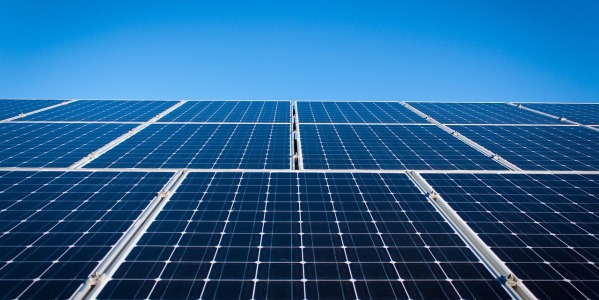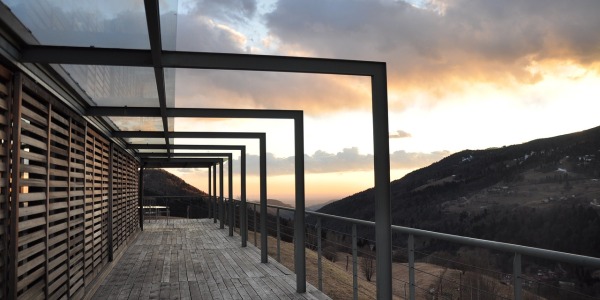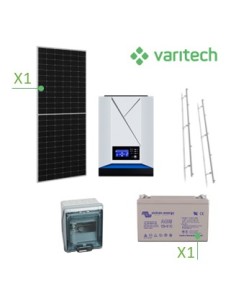- Redacción Varisolar
- Autoconsumo
- 0 likes
- 8202 views

Calculation and dimensioning of isolated photovoltaic solar installations
In this post we will tell you in detail how to calculate an isolated photovoltaic installation: How to calculate the number of necessary solar panels, battery, inverter, regulators, and other components that make up these installations.
The isolated photovoltaic solar installations They have the objective of providing electrical service to any consumer who is outside the public electrical distribution network. We can find ourselves here from a cabin that only has a light bulb, to a farm with a large electrical consumption.
Learn to know and analyze the expected consumption
The way it works is, taking advantage of the renewable resource of the sun, which on the one hand is infinite and free, and on the other hand is unstable and does not guarantee supply, in addition to providing energy only for a few hours a day. Therefore, to have an electrical supply in these isolated conditions that is uninterrupted, the most important thing is to do a good planning and selection of the material to be installed. It must be clear that the material to install in an isolated photovoltaic installation is not what one wants, but what is needed.
What elements does an isolated photovoltaic installation consist of?
In addition to having renewable energy resources as free as sun and wind, to have a totally guaranteed supply, we must complement our installation with an auxiliary electric generator that works with fossil fuels such as Diesel or Gasoline. Today we have no better option.
We are not going to talk about specific brands. But of equipment with certain technical characteristics so that it is applicable to any case. It is essential to always have a solar energy company with great experience and to provide the best possible advice. Therefore, haveVaritech It is a great option because #somosengineering. There's a lot online stores that sell solar kits, and they guarantee us a series of kWh. But is that really what I need? There are details that we will surely be overlooking.
The teams that we must select are:
Solar panels
wind turbine
charge regulators
Investor
batteries
Generator
Structure
Cabling
Calculate the panels
Currently, we have of the types of solar panels:
The classic 12 or 24V ones (due to their suitability for charging 12 or 24V batteries) or the high power monocrystalline ones. The use of the former is based on the fact that, having 36 or 60 cells respectively, their voltage is more or less similar to 12V or 24V batteries. Its use is widespread in campers or in micro-installations.
We do not recommend this type of panel since it is designed to charge batteries with very inefficient regulators that we will see later and are called PWM.
Modern monocrystalline panels range from 400W to 600W in a huge range of configurations and options.
.
You can see the peak power term most often referred to as kWp or Wp. And this basically means sum of panel power (its nominal value according to the STC standard). The peak suffix is added, because the reality is that in our country we never reach nominal power with normal STC because our radiation and weather conditions are not so favorable.
When we generally talk about dry kW, we are referring to nominal inverter power, which is what really counts for legalization purposes and to mention the size of the installation. We do not like to talk about kWp, ratherkW the panel.
How many solar panels are needed for my home?
We can choose what we want as long as we meet two criteria, connecting them in series (to increase voltage) and in parallel (several series with each other) to increase power.
Number of panels in series, multiplied by the open circuit voltage of the panel (data that appears in the data sheet as Voc), multiplied by a factor 1.1 must never exceed the maximum input voltage in direct current of the inverter or charge regulator that we select. We give an example: If we have an inverter whose maximum voltage is 500V, and we have 450W panels whose Voc is 50V, we will not be able to make a series of more than 9 panels.
If a series of 9 panels is not enough, we will have to configure several series in parallel, yes, all of them with the SAME number of panels. It is forbidden to put a series of different lengths in parallel.
The numbertotal solar panels will determine the peak power of our isolated installation, and it is very important to know how to size the peak power of panels.
Calculation of the inverter in isolated photovoltaic installations
This is the team in charge of converting energy stored in batteries into alternating current for the electrical supply. It is connected directly to the battery terminals, and has the ability to turn off when its voltage value is too low, or when, equivalently, its state of charge is insufficient. It will absorb both the power coming in from the charge controller and the battery itself at the same time, and once again we have to be careful with this.
At the domestic level, we find the small ones from 180W to 1200W that are simply an inverter, and the large ones of 3kW, 5kW or 7kW that usually incorporate functions such as a charger from a generator or network and even an integrated charge regulator.
We can limit, if we want, the maximum power that the inverter will be able to deliver by installing a circuit breaker of a lower caliber, as an ICP (power control switch). So:
10A | 2300W |
16A | 3680W |
20A | 4600W |
25A | 5750W |
32A | 7360W |
And this also allows reducing the maximum discharge intensity of the batteries and that they are protected.
It must be taken into account that, in the event of a short circuit, the inverter will trip before the automatic switch. Basically because its short-circuit capacity is relatively small enough to trip an automatic switch that trips magnetically at 10-12 times its rating.
In the event of an overload, the inverter will trip if the circuit breaker gives a power result greater than the size of the inverter and it will set an overload alarm, and it will trip the circuit breaker if it is used to limit power by setting it smaller.
Calculate the size of the inverter
It is very important that all parameters are properly adjusted in the inverter, such as the battery voltages to which they must stop, otherwise they will cause damage to them due to excessive depth of discharge.
Heinverter size will depend on what you want to connect to it. Normally for lighting, television, and small household appliances that do not have heating mechanisms (for example toasters) it is enough with 600-1200W nominal. If it is for a complete small house that does not have a pool and neither a pressure pump nor an irrigation system, a nominal 3kW is enough. If, on the other hand, you have a pressure motor, treatment plant, etc., it is advisable to go for a nominal 5 or 7kW.
At higher powers, such as farms or industrial facilities, a very different technology from the domestic one is used, which is called AC coupling and which we are not going to develop in this chapter, developed for general domestic use.
Calculate battery
To size and make this equipment compatible, we must check if the associated battery is capable of delivering all the power that this inverter is capable of demanding. To do this, we must divide the nominal power of the inverter between the voltage of the associated battery bank and check that the resulting intensity is compatible with the battery bank (Assuming that it is night and no panel load enters to consider an unfavorable scenario). For example, a 5kW inverter with a 48V battery bank can absorb up to 104A.
On the other hand, it is obvious that the inverter working voltage must be compatible with the associated battery bank, that is, we cannot connect a 24V battery bank to an inverter designed to operate at 48V.
At the level of wiring and protections, we must include a fuse with an intensity lower than the maximum allowed by the cable that goes to the battery. Also an automatic switch of a caliber less than the maximum allowed by the cable that comes out of the inverter (or enters to charge batteries if it has a connection to a generator or network).
Regarding differential protection, this type of installation is actually considered to have a neutral isolated from earth (IT type according to regulations) and does not necessarily require a differential because the installation is actually isolated from earth.
It is essential that all the masses are grounded and that the insulation from neutral to ground be monitored periodically and that it is greater than 0.5Mohm with a regulatory insulation meter through an authorized electrician.
Calculate Regulators
This equipment is designed to charge the batteries taking advantage of the production of the photovoltaic solar panels. We can find it by the name of solar charger or charge regulator, being the same device.
There are other types of battery chargers that we call electric chargers, which are a variant of these but that are fed from the electrical network or Diesel generator instead of solar energy.
In addition, there are special teams called dc dc converters that allow, from another battery (connected or not to an alternator), to charge a second battery or generate a different voltage (go from 12V to 24V or another similar case).
It has a charging algorithm so that the battery voltage is always adequate and we can distinguish 3 main phases:
: When the battery has greater capacity to absorb power, the intensity is higher
Absorption: at constant voltage, the intensity gradually decreases
Floatation: A standby voltage is set to maintain the battery at 100% charge.
equalization: The battery is subjected to a higher voltage than normal to desulphate the battery electrodes and thus increase its useful life (lead batteries only).
What type of charge regulator to choose for isolated photovoltaic solar installations?
At the time of selecting a charge controller we basically have two options.
PWM regulators
These regulators connect the solar panel directly to the battery, switching it according to a pattern of pulses called PWM (pulse width modulation). It is a kind of switch that opens and closes many times per second, connecting and disconnecting the panel and battery to regulate the amount of intensity that enters the solar panel to said battery.
In this way, you can make the panel work the battery on charge, absorption or float.
They are simple and robust equipment but which, during the charging phase, connect the panel directly to the battery. Therefore, they require the panel to work at the same battery voltage. Under these conditions, the panel is outside its maximum power point and will simply provide the corresponding current (a value between the maximum power current and the short-circuit current).
To calculate the power you can load at most, we must multiply the current of maximum power by battery voltage. This type of regulator requires special panels, whose working voltage is similar to the battery voltage. In addition, for your choice, we have to take into account that its nominal intensity capacity on the technical sheet is greater than the maximum intensity of the chosen solar panel (or sum of intensities if there are several panels in parallel).
MPPT regulators
They have the ability to make the panel work on their maximum power voltage, and thus, send the maximum possible power to the battery. They can generate up to 25% more power than PWM with the same panel.
Its cost is higher (double or triple), but its use is highly recommended. You can connect several panels in series but in its design you must observe the maximum input voltage provided. We cannot connect a set of panels in series whose voltage exceeds or may exceed the maximum admissible voltage of the regulator.
It is advisable to choose them so that the maximum power output that they have (product of maximum charging intensity by battery bank voltage, is between 5% and 20% less than the sum of peak power of panels associated with it.
These regulators have the ability to not inject more current into the battery than what they can handle, so it is not a problem to connect a solar field much higher than the maximum power that they can handle.
In fact, it is possible that many of them set maximum work intensity for special applications. These regulators are sold in currents from 10A to 100A, and maximum voltages from 75V to 250V. There are isolated inverters with integrated MPPT charge regulators, so that all the necessary electronics are contained in the same equipment.
In the previous graph we see how, when working at higher voltages with a regulator with MPPT in a panel of 36 cells, more power is produced (the value of the power-voltage curve in red is higher) than in a PWM regulator where it makes the panel work around 12V in the charging phase.
Steps prior to the installation of solar panels
At the time of selecting a structure for isolated photovoltaic installationIt is very important to know the roof where we are going to place it. If it is tile or if it is sheet metal, or even if you want to put it on the ground. In addition to knowing the assembly procedure according to the instruction manual of the structure that we are going to use.
It is important that said structure is approved and with its CE certification, so that it meets the standards of the technical building code. It is advisable to go to a technician who certifies that its assembly is adequate and that the place where we are going to anchor it is safe and supports the expected loads.
The solar structure that we are going to choose plays a very important role in the inclination of the plates and its orientation.
How to choose auxiliary generators to calculate and size an isolated photovoltaic installation
These teams generate electrical energy from Diesel or Gasoline fuel, and work on demand, that is, when necessary.
They can only be used to charge solar batteries, or to charge batteries and supply electricity to the home at the same time. The type of charger we have will depend on it.
If we go to connect to an electrical charger whose only mission is to charge the batteries, we just have to select a generator solar that has a nominal power at least 30%-50% higher than the maximum power absorbed by the electric charger (obtained by multiplying the voltage of the battery bank and the nominal intensity of the electric bank, giving the result in watts).
However, if we are going to use a combined inverter-charger, we must bear in mind that they have the ability to put themselves into bypass mode to power the house through the generator directly. And also, absorb power directly.
In this case, the calculation will be to add battery charging power(the same as before multiplying the maximum current of charge and voltage of the battery bank) and nominal power of the inverter. At this value we must look for a generator that has a nominal power at least 30%-50% higher than the previous result.
Choosing a larger than normal generator is not a problem from a technical point of view, except for the extra fuel consumption it will have.
Between gasoline and diesel, the advantages of choosing gasoline are its lower purchase price, but its higher operating cost (due to its higher consumption with respect to its power and the higher cost of fuel). In addition, the durability of gasoline is less than Diesel. Therefore, for occasional or emergency use we recommend gasoline (even with automatic start if we are looking for comfort). If it is to live in an isolated house all year round, it is better to choose a Diesel.
Are wind turbines worth it for isolated photovoltaic installations?
Wind turbines are elements that can charge the batteries using the push of the windas a source of energy. We must take into account that, unlike the sun, not everywhere is windy or the same amount.
To give us an idea, the commercial wind turbines They are designed to deliver their nominal power from a wind speed of approximately 12m/s, which is 43.2 km/h.
This speed is so high that it practically prevents two people from talking normally and also makes the ears whistle. Below this, production is linearly less from 3m/s, which is usually its starting speed.
Studying the real amount of wind is really complex, because, although there are wind resource maps, the local casuistry is difficult to determine without specific means such as anemometers with dataloggers.
Therefore, if we are looking for a wind turbine, let us calculate the actual days of wind that we can have, and assume that at most it will be able to give a maximum power of 30% of its nominal value.
We consider that, while the solar panel has dropped significantly in price, wind turbines have practically the same price as they did in 2007. While panels are easy to install and reliable,wind turbines have maintenance, lubrication, bearings, special foundations, etc. Therefore, we see much better investment in solar panels supported by a generator, which in wind power for small isolated installations. As always, except in very special cases.
Calculation and sizing of wiring and electrical installation in an isolated photovoltaic installation
The wiring that we must choose for isolated photovoltaic installations must follow theElectrical low voltage regulation, as well as the rest security measures and protections.
It must be taken into account that these types of facilities must be legally certified by authorized low voltage installers with the issuance of the corresponding electrical bulletin.
For sizing the wiring, we can follow the following table as a guide, which lists maximum power, maximum intensity and recommended cable section for alternating current monofásica 230V:
Power (W) | Current (A) | Cable section (Copper) |
2300 | 10 | 1.5 |
3680 | 16 | 2.5 |
4600 | 20 | 4 |
5750 | 25 | 6 |
7360 | 32 | 10 |
9200 | 40 | 10 |
And at the wire distance that we have is greater than 15 meters, it is advisable to go up one step in each section, up to 30 meters. If they are more than 30 meters, it is advisable to consult a specialist technician.
All metal equipment and metal parts have a ground connection or ground connection terminal. We must connect a cable that joins all of them and goes to a 2m stake stuck in the ground. It is recommended that an electric technician measure the operation of the grounding and verify that everything is correct. The cable to make all these connections must be of a section equal to or greater than that of the main alternating electrical conductors that we have in our electrical circuit.
For his solar panel wiring, we must use a cable with sufficient insulation and a section equal to or greater than 4mm2 for each string or series of solar panels. There is a specific type of solar cable called PV ZZ-F that has 1500Vdc insulation and is specifically designed for photovoltaic installations. If the distance from the cable to the solar panels is greater than 50m, it is advisable to consult a specialist.
It is important to use appropriate pipes according to regulations. Thus, if we use 1kV or higher insulation cables (hoses or solar cables), there is no problem in going outdoors without a tube as long as they have some type of mechanical protection or are out of the access of people. If we use 350V/750V cable with a PVC cover, they must always go under a tube or gutter.
The connections to solar panels must always be made with MC-4 connectors so that the same connection method for which they are designed is used and the tightness of the joint is guaranteed by means of this type of connector.
We recommend using fuses, one positive/negative pair per string for maintenance and surge protection. These fuses must have a nominal capacity of 20 A (or what is recommended by the technical data sheet of the solar panel) and must be specifically designed to work at 1000Vdc, both base and fuse.
It is normal to use the standard 10x38mm size. Some manufacturers indicate that the fuse is not necessary, and they may be right, but it is true that if an overvoltage occurs and the inverter has class II protection for it, it will lead to an overcurrent that will blow the fuse and protect the installation.
we have to know that the fuses will not protect against short circuits or friction in the cables, because the size of the fuse will always be greater than the short-circuit current of the panel. Therefore, to prevent fires, we must take extreme precautions with the routing of the solar cable that is sufficiently protected from rodents and scratches or damage to its insulation.
.
For select battery cable, we must take into account that it should not be longer than 3 meters (if more is needed, consult a specialist), and the cable section must be in accordance with this table:
A 12V
Power (W) | Current (A) | Cable section (Copper) |
1260 | 105 | 16 |
1476 | 123 | 25 |
1848 | 154 | 35 |
2256 | 188 | 50 |
2928 | 244 | 70 |
3552 | 296 | 95 |
4176 | 348 | 120 |
A 24V
Power (W) | Current (A) | Cable section (Copper) |
2520 | 105 | 16 |
2952 | 123 | 25 |
3696 | 154 | 35 |
4512 | 188 | 50 |
5856 | 244 | 70 |
7104 | 296 | 95 |
8352 | 348 | 120 |
A 48V
Power (W) | Current (A) | Cable section (Copper) |
5040 | 105 | 16 |
5904 | 123 | 25 |
7392 | 154 | 35 |
9024 | 188 | 50 |
11712 | 244 | 70 |
14208 | 296 | 95 |
16704 | 348 | 120 |
Buy components for photovoltaic installations
At Varisolar you will find all the components you need to ride your own isolated photovoltaic installation.
In our online store we have a wide variety of products to supply energy to your home, country house, caravan, industrial warehouse or boat.
In addition, if you require it, we also put at your disposal a team of professionals who will take care of all this process to find the solution that best suits your needs, starting up photovoltaic installations in Granada and Malaga.
Últimos artículos



